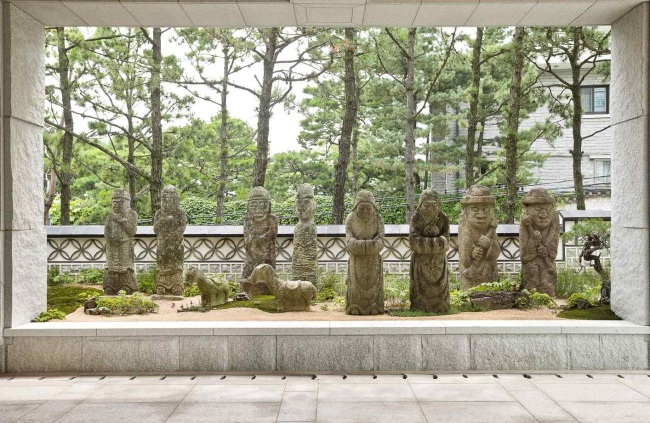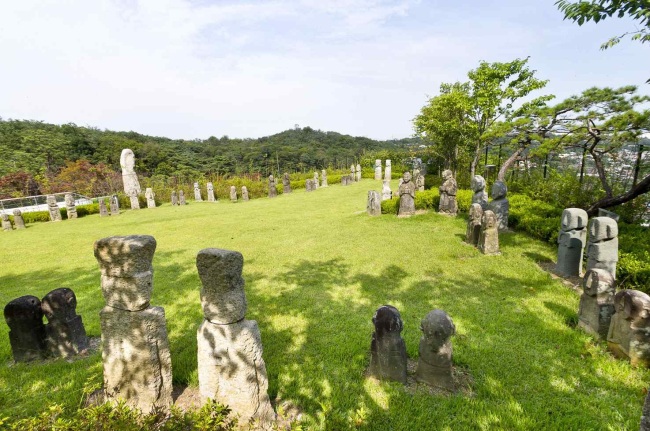Stone sculptures had a significant impact on the ordinary lives of people in Korea as symbols of various folk beliefs.
One old folk belief had women, hoping to conceive, visit child stone statues and pray for the arrival of a son. Some women even took parts of the stone sculptures home and ground them to eat with water. This caused many women to suffer appendicitis, one of the major causes of death for women during the Joseon era.
Stone sculptures that carried different wishes of ordinary people in Korea have been gathered for a public display at the Korean Stone Art Museum, which opened on Nov. 11, on the hillside of Mount Bugaksan in Seongbuk-dong in the northern part of Seoul.
 |
Janggunseok, stone statues of military officers that served as tomb guardians (Korean Stone Art Museum) |
The private museum, comprised of a three-story building and a huge outdoor exhibition space, features a private collection of more than 1,000 stone sculptures, spanning from the Silla Kingdom (B.C. 57- A.D. 935) to Joseon era (1392-1910).
The owner of the collection was revealed to be corporate magnate Chun Shin-il, chairman of Sejoong and close acquaintance of former President Lee Myung-bak. The museum features Chun’s lifetime collection of stone statues and modern and contemporary paintings, accumulated over the past 40 years.
“(I’ve been) fascinated by the innocent and rough beauty of old stone artworks and our traditional stone sculptures, many of which had been removed from their original locations and dispersed across the nation,” said Chun, at the museum opening.
Most of the stone statues on display are guardian statues that stood at the entrance of villages and grave sites. The museum said most statues made by common people were left without care, or buried underground and abandoned.
“The museum has a lot to research and study the stone statues made and used by ordinary people in the old days,” said Ju Yeon-gyung, curator of the museum.
 |
Stone sculptures are on display in an outdoor garden at the Korean Stone Art Museum. (Korean Stone Art Museum) |
The museum dedicates a large space to Beoksu statues, village guardian statues which used to stand at the entrance of a village to protect residents from evil spirits and illnesses. Beoksu statues appear in various forms, ranging from farmers, musicians, scholars and warriors to children, each representing different wishes, such as longevity, fertility, prosperity and good health.
“Stone sculptures representing folk beliefs feature humorous and humble images. The child ‘dongja’ statues and beoksu are not artistically detailed, but they represent wishes of ordinary people in Korea,” said Ju.
The statues also show varying artistic craftsmanship depending on the region they were discovered. Those found in Seoul and Gyeonggi Province feature a high level of stone carving techniques, as the area had the nation’s top skilled stone carvers.
Various totemic animal sculptures, originally located at old grave sites, found a new home in the outdoor museum space. The represented animals are diverse, from sheep and tigers to horses, each holding a different meaning. Sheep sculptures were made to fend off evil spirits, tigers were situated to guard graves and horses were supposed to carry the deceased to the afterlife.
The museum also offers themed walking paths, such as “The Road to Success” where visitors can walk along stone statues that represent success and prosperity.
The museum is closed on Mondays. Admission is 7,000 won ($6) for adults, 5,000 won for teenagers and 3,000 won for children. Guided tours run at 11 a.m. and 3 p.m. For more information, see
http://www.koreanstonemuseum.com.
By Lee Woo-young (
wylee@heraldcorp.com)









